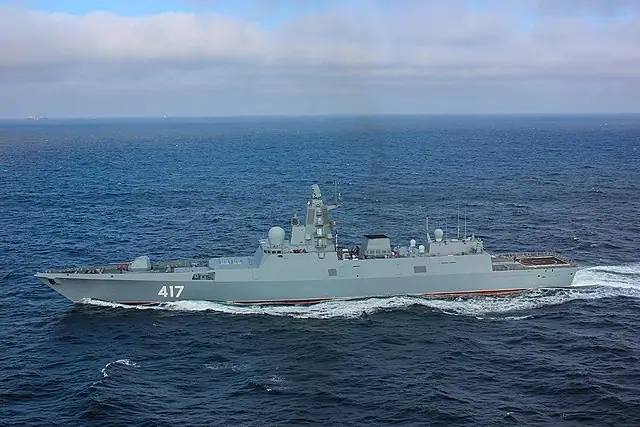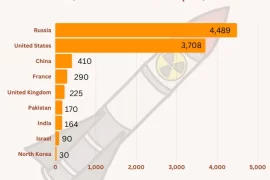The Admiral Gorshkov class multi-role frigate, also known as Project 22350, represents a significant leap forward for the Russian Navy in terms of modernization and firepower. This article delves into the key aspects of this formidable warship, from its impressive weaponry to its stealth features and its role in revitalizing the Russian surface fleet.
A Post-Cold War Powerhouse
The Admiral Gorshkov class multi-role frigate, designated as Project 22350, is a testament to Russia’s commitment to bolstering its naval capabilities in the post-Cold War era. These frigates are the largest surface combatants built in Russia following the end of the Cold War, showcasing the nation’s determination to remain a formidable maritime force.

The Admiral Gorshkov class is a product of the renowned Severnoye Design Bureau, located in St. Petersburg. Founded in 1946, this design bureau has a rich history of developing surface warships. Its products include iconic vessels like the Kirov-class battlecruiser and the Slava-class cruiser.
The lead ship of the class, the Admiral Gorshkov, began its construction at the Severnaya Verf Shipyard in St. Petersburg in February 2006. However, it faced delays in fitting out. It was not until 2018 that the frigate was finally commissioned, reflecting the complexities of modern naval vessel construction.
Admiral Gorshkov Class Frigate: Key Features
While primarily designed for anti-submarine warfare, the Admiral Gorshkov class frigate is not limited to this role. It boasts formidable anti-ship firepower and area air defense capabilities. It fills a crucial gap in the Russian Navy’s surface fleet, which lacked such capabilities in previous generations.
Lethal Firepower
The Gorshkov class frigate is armed with a formidable array of surface-to-surface cruise missiles. It has 16 vertical launch cells dedicated to Kalibr, Oniks, and Zircon missiles.
The Kalibr, in particular, stands out for its subsonic-sea-skimming-supersonic capability, making it a versatile anti-ship weapon. The Poliment-Redut air defense system, equipped with a multi-tier missile defense capability, ensures protection against aerial threats.
Gorshkov frigate also stands out as one of the few Russian warships to have successfully test-fired the Zircon hypersonic missile. This cutting-edge weapon system poses a significant threat to opposing surface vessels, thanks to its incredible speed and maneuverability, making it challenging to intercept.
One of the most striking features of the Admiral Gorshkov class frigate is its remarkable firepower, which belies its relatively small displacement. Whether engaging surface or underwater targets, this warship packs a potent punch, making it a versatile asset for the Russian Navy.
Stealth Technology Integration
In contrast to the conspicuous design of most Soviet-era warships, the Admiral Gorshkov incorporates modern stealth technologies. Its sleek and enclosed superstructure minimizes its radar cross-section. This makes it a challenging target for enemy detection systems. This stealthy design aligns with contemporary naval warfare trends. It also emphasizes the importance of remaining hidden from adversaries.
The Gorshkov class stands out with its elongated front section, narrow front half, and superstructure placement towards the rear. This design allows for the integration of 48 vertical launch cells, accommodating the Poliment Redut air defense system and cruise missiles. The ship’s displacement of 5,400 tons categorizes it as a heavy frigate, approaching the size of a destroyer.
The frigate employs a combined diesel and gas propulsion system. It has two shafts powered by Kolomna 10D49 diesel engines for slow cruising and UEC M90FR gas turbines for high-speed operations. Its maximum speed reaches 29.5 knots. It has an operational range of 7,400 km at cruising speed and a remarkable endurance of 30 days. These features make it a versatile blue-water capable vessel.
The Admiral Gorshkov’s stealth characteristics include an enclosed superstructure and angled hull sections designed to deflect radar waves. While some topside clutter exists due to electronic equipment, the ship’s design aims to minimize its radar cross-section. This enhances its survivability in modern naval warfare scenarios.
Anti-Submarine Capabilities
To counter submarine threats, the frigate employs 8 torpedo tubes capable of launching the Paket-NK torpedo, known for its dual role in targeting submarines and intercepting incoming torpedoes. This active hard-kill measure enhances the ship’s anti-submarine warfare capabilities significantly.
Aviation Assets
A Ka-27 helicopter, housed in the internal hangar, plays a crucial role in anti-submarine operations. Modernized with advanced avionics and radar, this helicopter contributes to both anti-submarine duties and the spotting of surface targets for long-range engagement.
The Gorshkov class frigate is at the forefront of the Russian Navy’s modernization plans. It marks a critical step after more than a decade of stagnation due to funding limitations following the collapse of the Soviet Union. These frigates will replace aging Neustrashimyy and Krivak-class anti-submarine frigates, offering a significant enhancement in capabilities.
To rejuvenate its fleet, the Russian Navy has launched three Admiral Gorshkov class frigates, all assigned to the Northern Fleet. However, plans call for the construction of more than a dozen of these frigates by 2030. With deployments anticipated in the Pacific and Black Sea Fleets, these frigates will reinforce Russia’s maritime presence.
The Future of the Gorshkov Class
The Russian Navy’s commitment to the Admiral Gorshkov class frigate is evident in its plans to expand the fleet. It will potentially develop a more formidable “Super Gorshkov” variant. These frigates represent a vital step in revitalizing Russia’s surface fleet and reinforcing its maritime presence in strategically significant regions.
In conclusion, the Admiral Gorshkov class multi-role frigate, with its advanced weaponry, stealth features, and multi-role capabilities, symbolizes Russia’s determination to remain a formidable naval power in the 21st century. As these frigates continue to join the ranks of the Russian Navy, they contribute to the nation’s maritime strength and play a critical role in modern naval warfare scenarios.







